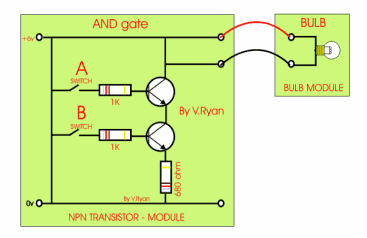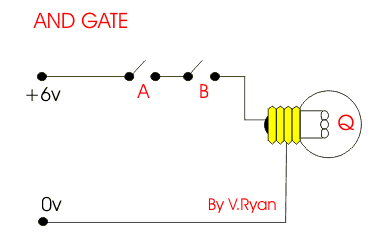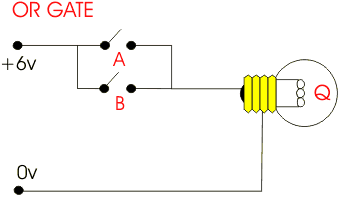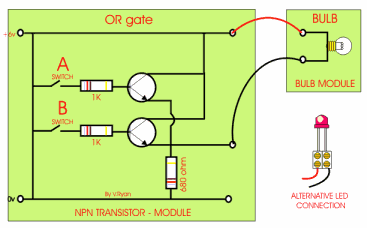| CLICK HERE FOR INDEX PAGE | |
| DIGITAL ELECTRONICS - LOGIC CIRCUITS - 2 | |
| V. Ryan © 2003 - 2009 | |
|
PDF FILE - CLICK HERE FOR PRINTABLE WORKSHEET BASED ON INFORMATION BELOW |
|
|
LOGIC circuits are normally composed of gates. A combination of gates make up a circuit and some digital circuits can be extremely complex. It is the logic gates that produce pulses of electrical current (1s and 0s). At school level, digital logic circuits are relatively simple. Below are simple drawings that help explain the two most popular logic gates - the AND gate and the OR gate. |
|
|
|
The simplified AND gate shown above has two inputs, switch A and switch B. The bulb Q will only light if both switches are closed. This will allow current to flow through the bulb, illuminating the filament. |
|
|
|
|
|
The simplified OR gate shown above has two inputs, switch A and switch B. The bulb Q will light if either switch A or B are closed. This will allow current to flow through the bulb, illuminating the filament. |
|
|
|
|
When the bulb lights this represents a 1 as current is running through the filament. If current is not running through the filament the bulb will not light and this represents a 0 (zero). |
|
|
THE ROLE OF TRANSISTORS |
|
|
Transistors are vital for digital circuits to work.
These components are used as very fast switches in digital logic
circuits. Transistors are normally so small that hundreds of thousands
fit on one processing chip on a computer motherboard. The types of
transistors used in school projects are normally large enough to fit on
the end of a small finger. However, the way they switched on and off is
the same (click here for transistor information
sheets) . When a transistor is switched on it produces a 1
and when it is switched off it produces a 0.
|
|
 |
This is an AND gate
circuit and it can be made quite easily. The example shown is built from
a modular electronics kit. Both switches A
and B must be pressed together for the
bulb to light. |
|
|
This is an OR gate circuit. Either switch A or B must be pressed for the bulb to light. The switches do not have to be pressed together. |
|
QUESTIONS: |
|
|
|
|


